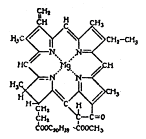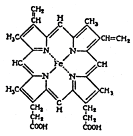
Xenology: An Introduction to the Scientific Study of Extraterrestrial Life, Intelligence, and Civilization
First Edition
© 1975-1979, 2008 Robert A. Freitas Jr. All Rights Reserved.
Robert A. Freitas Jr., Xenology: An Introduction to the Scientific Study of Extraterrestrial Life, Intelligence, and Civilization, First Edition, Xenology Research Institute, Sacramento, CA, 1979; http://www.xenology.info/Xeno.htm
10.4 Alien Blood
It has been suggested that the color red is used to signify danger in so many human societies because it is the color of blood. We associate red with blood and bleeding, which in turn are associated with pain, bodily injury, or death. If the blood of ETs is, say, green (Figure 10.1) instead of red, one writer speculates, they "would think green a quite natural index of danger and be amused at the idea of using red."2552
Virtually all higher organisms on this planet circulate body fluids of one form or another. The grasshopper has a circulatory system involving blood and many hearts -- though it is used only for food and waste, and not oxygen, transport. The earthworm has an advanced pumping network with five pairs of hearts, and the squid has two pairs -- one at each gill to circulate fresh oxygenated blood, the other pair for returning spent blood. In the human body, a heart weighing about half a kilogram pumps 8000 liters per day through approximately 96,000 kilometers of vessels and capillaries.
Figure 10.1 Alternate Blood Chemistry in Science Fiction

Mr. Spock, the extraterrestrial Science Officer of the Federation starship Enterprise, has green blood coursing through his veins. © 1976 Paramount Pictures
One of the most important functions of circulatory fluid is to deliver oxidant to the organism’s cells, by dissolving more of it than would normally be possible in plain water. On Earth, where gaseous oxygen is the most common oxidant in general usage, the utility of blood in this regard is greatly enhanced by the presence of pigments. These pigments are able to combine "reversibly" with O2, picking it up in lung or gill and ferrying it along to the cells. For instance, pigments found in mammals typically can carry some 250 cm3 O2 per liter of blood, as compared to a mere 5 cm3 O2 that can be dissolved in a liter of ordinary seawater at the same temperature.
The way oxygen transport works is rather clever. Nature has discovered that certain substances will chemically combine with oxygen at high partial pressures, but that if the pressure is lowered past a certain point, the gas is let go again. By maintaining a high partial pressure in the respiratory organ of an animal, and a comparatively low pressure within its cells, O2 may be picked up by the blood pigment in the lungs and later forced to give it up when it reaches the body tissues.
The most successful such pigment on this planet is hemoglobin (Hb), a member of the same class of porphyrins to which chlorophyll belongs (Figure 10.2). A hemoglobin molecule consists of a porphyrin ring with a central iron atom (heme), hooked to a giant clump of protein called globin. Hemoglobins are present throughout the entire animal kingdom, in all vertebrates (except a few Antarctic ice-fish1691) and in the circulatory fluids of many invertebrates as well (annelid worms, many arthropods, and some echinoderms, mollusks and crustaceans).
| |
(hemoglobin) |
 |
 |
Hemoglobin remains the most efficient oxygen-carrier known. For the better part of this century, chemists have labored in vain to create other substances that could do a better job. Nevertheless, several other pigments have been discovered and utilized in nature.* These, while not as efficient as hemoglobin, still are able to serve as adequate oxygen-transporters in certain environments (Figure 10.3).
The copper-containing pigment hemocyanin, second in breadth of distribution only to hemoglobin, is found in the blood of various mollusks and arthropods.195,723 Unlike human blood, which is bright red in the arteries (oxygenated) and dark red in the veins (deoxygenated), hemocyanin blood is a beautiful blue in the arteries and crystal—clear colorless like water in the veins.
Hemocyanin is always found floating freely in the blood plasma, rather than being trapped inside corpuscles as are the relatively smaller molecules of Hb. This copper-based, proteinous, non-porphyrin blood pigment is only about 25% as efficient an oxygen carrier as hemogIobin.734 Might true extraterrestrial "blue bloods" exist? On a world with very high surface pressures and abundant oxygen we might suspect that the higher efficiencies achieved by Hb might not be needed for survival. Hemoglobin might then never have evolved at all.
Figure 10.3 Respiratory Pigments for Alien Bloodstreams
Another free-floating respiratory pigment found in various tubular annelids (Polychaeta), also only about a quarter as efficient as Hb, is chlorocruorin.723 Solutions of this iron-based pigment are green in natural dilute solutions, but in higher concentrations become vivid red in color. The blood of one species, Serpula vermicularis, is remarkable in that it is a dual hemoglobin/chlorocruorin pigment system.
Hemerythrin is iron-containing proteinous pigment found in the blood of certain bottom-dwelling marine worms (nematodes, annelids) and brachiopods. It serves as a reversible oxygen carrier, but is far less efficient than hemoglobin. Blood containing this pigment is a bright pink or violet when oxygenated, but turns colorless by the time it reaches the veins. A small molecule like Hb, it must be confined to corpuscles in the bloodstream rather than allowed to float about freely.
Another pigment is called vanadium chromagen.1650 This is found in the blood of sea squirts, ascidians, and tunicates. Confined to tiny corpuscles known as vanadocytes, the blood containing these tiny packets is usually apple-green in color but can also be found in blue and orange varieties, presumably due to the presence of different oxides of vanadium.1070 Although still questioned by some, vanadium chromagen appears to take up and release O2 freely in acidic solutions.
There are a few others known to biologists, such as the copper-based porphyrin found in the wing feathers of Turacus indicus and the occurrence of a manganese-based porphyrin in the blood of the mollusk Pinna squamosa (called "pinnaglobin," a brownish pigment), whose respiratory functions have not yet clearly been established.
Lifeforms on other worlds could use various combinations or varieties of any of the above to get oxygen to their cells. Their blood could take on virtually any color, as we have seen. But does the inventory of natural techniques on Earth exhaust the possibilities?
Not by a long stretch. Despite the undisputed fact that reversible oxygen binding is a comparatively rare biochemical property, there are many alternatives never seen by nature. For more than half a century now, chemists have been reporting the synthesis of Hb-like molecules, not occurring in nature, capable of reversible combination with oxygen.734 For example, a simple iron-indigo compound seems to work quite well.2411
Porphyrin complexes of dozens of metallic elements have been studied carefully in this regard.914,918,1068 Chemists have discovered suitable manganese and cobalt complexes unknown in terrestrial respiratory systems. Since early in this century, in fact, a wide range of cobalt histidines and "coboglobins" have been investigated in depth. (See especially the work of Hearon et al.,914 Hoffman and Petering,916 Martell and Calvin,1067 and Michaelis.915,2414) They appear most promising for use in possible alien biochemistries. There is some precedent for this on Earth: Vitamin B-12 is a cobalt-based porphyrin.
Coboglobin blood would be colorless with a faint pinkish tinge when loaded with oxygen, but in the veins would take on a dark yellow or deep amber color. Since coboglobin protein is a lightweight molecule like hemoglobin or hemerythrin, we might expect ET blood to carry the pigment in corpuscles.**
After many cycles of use, a molecule of coboglobin gets old and "tired."
It loses its ability to reversibly bind oxygen. While this aging takes weeks in the case of normal human hemoglobin, less than a day is required for coboglobins to poop out. As this "irreversible oxygenation" sets in, the pigment changes color dramatically from amber to deep pink.
But this should pose no insuperable problem for ETs. We know that millions of human blood cells are broken down and rebuilt each minute of our lives. It is not implausible to suggest that alien organisms may have evolved a more efficient biochemical apparatus for the recycling and reconstitution of blood pigment than have Earthly animals.
It is doubtful that the relative scarcity of cobalt compared to iron will rule out the existence of coboglobins in alien blood. While the element is about 1/100 as abundant as iron in the seas, it is approximately as abundant as phosphorus, chlorine, and potassium, all of which are common in mammalian biochemistry. And the two elements copper and vanadium -- used by terrestrial lifeforms in the O2-transporting blood pigments hemocyanin and vanadium chromagen -- are almost an order of magnitude scarcer than cobalt in the cosmos and are of comparable abundance on planetary surfaces.***
Another interesting though less likely possibility is iridium-based blood. One simple compound with an absolutely horrible name (chloro-carbonyl-bis(tri phenylphosphine)-iridium) has recently been shown to undergo reversible oxygenation.919,920 This substance is insoluble in water and other polar media such as liquid ammonia and alcohols, but this presents no barrier to its use in blood. The vanadium chromagen found in ascidians is also insoluble in water.
In solution, the compound takes up one atom of oxygen per molecule to change from brilliant yellow to sullen orange. The reaction is not quite as fast as with the cobalt complexes, so a more convoluted lung would be necessary.
In the oxygenated condition, the iridium-based blood of extraterrestrials would have to be protected from light because it is very photosensitive. The pigment slowly decomposes over a period of days or weeks when exposed to strong light, gradually changing color from orange to green and finally to a deep bluish-black. Such aliens would therefore either have very dark skin, or would inhabit a dimly lit world. (In the absence of light, the molecule is stable for years.)
The iridium complex has one additional property which is extremely fascinating to xenobiologists. In addition to oxygen, the molecule is also capable of reversibly binding hydrogen as well!
Many other reversibly binding compounds can probably be found if chemists search for them diligently. And we haven’t even really considered the possibility of ETs using oxidants other than oxygen. To date, chemists have scarcely considered reversible chlorine- or sulfur-binding molecules which might serve as respiratory pigments in the bloodstreams of truly alien extraterrestrials.
* Most animals with colored blood (except insects) obtain that color primarily from the respiratory pigment. Naturally, since substances of all kinds may be dissolved in the circulatory fluids of an animal, the possibility of blood of any color cannot be positively ruled out. However, in most respiratory terrestrial species it remains true that the blood is vividly colored according to the particular oxygen transport pigment used.
** Like hemocyanin, hemerythrin and coboglobin are not destroyed by carbon monoxide as is hemoglobin in human blood. Organisms with these kinds of blood pigments thus would not be poisoned by the gas, as humans are.
*** Cobalt, not iron, may lay claim to the simplest oxygen binding molecule on record. Cobalt forms a complex with ammonium hydroxide (ammonia dissolved in water) which is capable of reversible behavior. The carrier molecules have a mean lifetime of only a few hours, so must be rapidly recycled much like coboglobin.914
Last updated on 6 December 2008